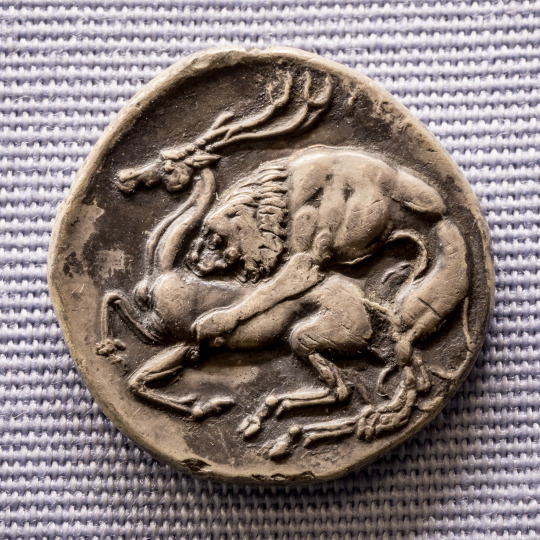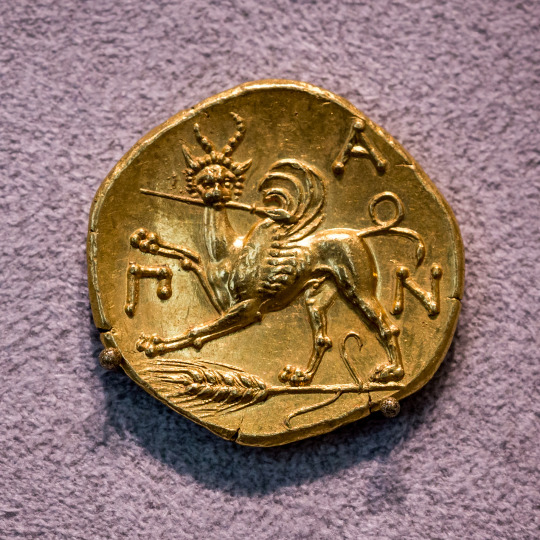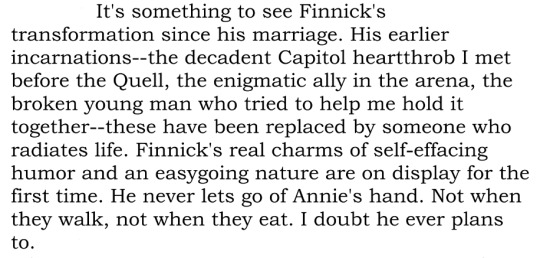#greek coins
Text

A lion attacks a stag. Reverse of a silver didrachm issued by the polis of Elea in southern Italy between 420 and 380 BCE. The obverse, not shown, bears the head of Athena. Now in the Staatliche Münzsammlung, Munich, Germany. Photo credit: ArchaiOptix/Wikimedia Commons.
#classics#tagamemnon#Ancient Greece#Magna Graecia#Classical Greece#art#art history#ancient art#Greek art#Ancient Greek art#Classical Greek art#coins#ancient coins#Greek coins#Ancient Greek coins#didrachm#numismatics#ancient numismatics#Staatliche Münzsammlung#animal violence tw
569 notes
·
View notes
Text

Mythical Animals on Romans coins:
The presence of animals and religious beliefs on Roman coins reflects the intertwining of cultural symbolism and political propaganda in ancient Rome.
Animals on Coins as Symbolism of Power, Animals depicted on coins often represented strength and sovereignty.
Cultural Significance : The portrayal of animals like horses or mythical creatures such as Pegasus served to connect emperors with divine or heroic narratives, enhancing their legitimacy and authority.
Religious Beliefs/ Animal Sacrifice, Animal sacrifice was central to Roman religious practices, believed to appease the gods and ensure societal harmony. The rituals involved specific procedures and were deeply embedded in their religious life, reflecting the Romans' obligation to maintain proper rites (religio) to avoid divine displeasure.
Integration of Beliefs The incorporation of animal motifs on coins can also be seen as a reflection of broader cultural shifts, particularly during the transition from paganism to Christianity, where the understanding and significance of animals evolved. #archaeology #history #ancient #art #Caesar #ancienthistory #archaeological #rome #italy #roman_empire #roma #heritage #roman_republic #archaeologylife #Orichalcum #Roman_mythology #italia #medallion #romancoin #romanarcheology #romanancientcoins#aureus #denarius #dupondius #follis #antoninianus #sestertius #fils #alsadeekalsadouk #الصديق_الصدوق
#history#archaeology#culture#photography#travel#palestrina#roman coins#sidon saida tyre beirut phoenician الصديق_الصدوق#الصديق_الصدوق#greek coins
107 notes
·
View notes
Text
When you’re shopping for gifts and find something young you would really want

#greek artifacts#greek vase#greek plates#ancient greece#ancient antiquities#pottery#greek coins#archaeology#scientific explorer#toys
10 notes
·
View notes
Text
Coin of the Day #14 (5/18/2024)
A little Thrace for Saturday…


Kingdom of Thrace
AE12 - 1.94g
Lysimachos 305-281 BC
Lysimacheia Mint
Obverse Head of Athena right, helmeted
Reverse ΒΑΣΙΛΕΩΣ ΛΥΣΙΜΑΧΟΥ
Lion head facing front
SNG Cop 1170, Mueller 12
#coin of the day#kingdom of thrace#thrace#Lysimachos#ancient greece#greek coins#coin#coins#numismatics#ancient coins
5 notes
·
View notes
Text
My brother got me this incredibly pretty necklace for my birthday!

12 notes
·
View notes
Text

~ Coin, Tetradrachm: A. Head of Athena, three olive leaves on the helmet; B. AΘE
Country/Issuer: Ancient Greece, Attica Athenes
Date: 5th century B.C.
Medium: Silver
#ancient#ancient art#history#museum#archeology#archaeology#ancient history#coin#ancient coins#money#numismatics#athens#attica#ancient greece#greece#ancient greek#tetradrachm#athena#silver#5th century B.C.
3K notes
·
View notes
Text
People usually draw Athena with barn owls or larger great horned owls, probably because they are more well known in the United States and they are more "intimidating" by their wing span and appearance, but I find it sweet that the "owl of Athena" is the little owl, Athene noctua.
It occurs in Europe, Central Asia, and parts of Africa, making it a more obvious bird for a Mediterranean Goddess. It's also so small you can hold it on your hand/fingers (it's around 8in/22cm in length with a wingspan of 22in/56cm).
Athene noctua is also related to Athena etymologically: γλαυξ (glaux, used to describe the little owl), the word connected to γλαυκός (glaukos, "bright", "light blue", "light grey", "gleaming"), is also connected to the epithet γλαυκῶπις (glaukopis, "of gleaming eyes") that was a constant epithet of Athena. They were probably associated because of the "gleaming" eyes of the little owls. The specific shade of that "gleaming" might also be descriptive of the bluish shine on olives when they're ripe, which would connect to another specific attribute of Athena.
213 notes
·
View notes
Text

#hermes worship#hermes#mercury#hermes god#ancient greek god#greek god#coin#greek myth#greek myth art#ancient greek mythology#greek mythology#ancient greek coin#roman coin#medieval coin
2K notes
·
View notes
Text
Coins are Essential to Hellenic Worship and Witchcraft

In Ancient Greece Drachmae (the coins/currency of the time) were used not just in everyday life but honoring the dead. It was believe that coins were offered to the deceased right before they were buried. The coins were given to grant the spirits passage to the underworld by paying Charon who will ride across Acheron, a river in the underworld to the afterlife, fearing they will get stuck on the shores if they don’t have the payment to cross. Though it is a very old superstition it is still very important to offer such a gift to the spirits that crossed over, though whether you don’t believe such a belief or do about paying the ferryman the act of the gesture is a sign of great respect and admiration for the departed. Collect your spare change and don’t be afraid to use them for various reasons:
- Offer them to your ancestors.
- Place a coin on gravestones when you visit a cemetery.
- Offer coins to your deities as money being one of the great sacrifices to give to them even if it’s just a penny.
You can also do spell work with coins as charms, divination (flipping heads or tails), talismans, focal point of power, etc.
#hellenic polytheism#paganism#norse paganism#witchcraft#coins#money#ancient greece#hellenic pagan#hellenic worship#greek mythology#ancestral worship#ancestors#spirit work#death witch#death witchcraft#spirit communication
149 notes
·
View notes
Text


An ancient coin I own with a portrait of Zeus on one side, and a depiction of him enthroned on the other. I actually forgot how old this is but I'm guessing Hellenistic period??? I keep it on my altar. :3
#hellenic polytheism#hellenic pagan#greek polytheism#paganblr#paganism#religion#hellenic paganism#theoi#helpol#history#ancient history#ancient greece#hellenistic#hellenic#ancient coins
51 notes
·
View notes
Text


Gold stater (diameter=18 mm; weight=9.09 g) from the ancient Greek city of Panticapaeum, a Milesian colony on the Black Sea. The obverse bears the head of the god Pan, shown in three-quarter view and crowned with ivy. The reverse depicts a griffin with a spear in its mouth, standing on an ear of grain (the Black Sea region was an important center of grain production for the ancient Mediterranean world). Around the griffin are the Greek letters ΠΑΝ. Now in the Münzkabinett der Staatlichen Museen, Altes Museum, Berlin. Photo credits: ArchaiOptix/Wikimedia Commons.
#classics#tagamemnon#Ancient Greece#ancient history#art#art history#Greek art#Ancient Greek art#Panticapaeum#Greek religion#Ancient Greek religion#Hellenic polytheism#God Pan#coins#ancient coins#Greek coins#Ancient Greek coins#stater#numismatics#ancient numismatics#metalwork#goldwork#Altes Museum
407 notes
·
View notes
Text

The use of hippocampus on coins
-Greek Civilization:
In Greek mythology, the hippocampus was often associated with Poseidon, the god of the sea, earthquakes, and horses. Poseidon was said to ride a chariot drawn by hippocampi, which symbolized his dominion over both land and sea. The hippocampus also appeared in ancient Greek art, particularly in pottery and mosaics, where it was depicted as a graceful and powerful creature. These representations often emphasized its role as a creature of the sea, embodying both the beauty and the danger of the ocean.
-Phoenician Civilization:
The Phoenicians, a seafaring people known for their trade and maritime prowess, also featured the hippocampus in their art and mythology. The hippocampus in Phoenician culture symbolized their connection to the sea, which was central to their economy and way of life. The creature was depicted in Phoenician art, particularly in the form of amulets, seals, and decorative items, serving as a protective symbol for sailors and merchants.
-Roman Civilization:
In Roman culture, the hippocampus continued to be associated with the sea and was often linked to Neptune, the Roman equivalent of the Greek Poseidon. The Romans adopted and adapted much of #Greek_mythology , so the #hippocampus retained its significance as a creature of the sea. It appeared in Roman mosaics, sculptures, and other artworks, often in scenes depicting marine life or the gods of the ocean. The hippocampus also symbolized power and strength, qualities that were highly valued in Roman society.
In all these civilizations, the hippocampus served as a powerful symbol of the sea, embodying the duality of beauty and danger, as well as the connection between the human and the divine. #archaeology #ancient #ancienthistory #museum #numismatics #numismatist #numismatica #rarecoins #oldcoins #worldcoins
#coincollecting #coincollection #gold #metaldetecting #silvercoins
#coin #romancoin #ancientcoins #ancientgreekcoins #money #history.
#temple#art #greece #alsadeekalsadouk #الصديق_الصدوق
57 notes
·
View notes
Text





Thinking about how Suzanne Collins writes romance in The Hunger Games along the lines of the soulmate myth where two halves of a whole complete one another
#and thg is very inspired by greek mythology so the soulmate myth was very likely incorporated on purpose#the concept of needing someone to be yourself#annie and finnick always being described as one being especially gets to me#like thats just platos concepts verbatim#also another tangent but hunger games explores the different types of love like agape or eros all of which were coined by plato#its all really done well because at the end of the day miss collins penned love is necessary and it shows throughout the entire story#love that everlark not only represents choice between war/peace but also your other half that makes up for what you lack#the hunger games#thg#katniss everdeen#peeta mellark#everlark#finnick odair#annie cresta#odesta#greek mythology
143 notes
·
View notes
Text
Coin of the Day #10 (5/14/2024)
Teeny Tiny Tuesday…?


Caria
AR Obol - 8mm 0.64g
500-400 BC
Uncertain Carian Mint
Obverse Female head left, wearing sakkos
Reverse Lion head facing front, in incuse rectangle
SNG Kayhan 983
6 notes
·
View notes
Text

Ethiopian coin depicting King Endubis of Axum. The ruling elite of Ethiopia at this time were typically bilingual capable of understanding both Greek and Ethiopic(Ge’ez). He reigned from 270 to 300 CE.
#endubis#ethiopia#african history#axum#axumite#axumite empire#art#culture#coin#currency#greek#ancient#ancient art#ancient history
75 notes
·
View notes
Text
Exoudénmate;;
[PT: Exoudénmate;; ]


pronounced as (ex-oo-din-mate) !!
with two different versions (because tumblr ate the third up tbh) :D !!
colors based off;; idk started with vaporwave and then i got silly w it
A label for introjects of all kinds who are so source seperated in one way or another that they feel as if they no longer are an introject at all !!
Requested by;; anon !!

name explanation;;
originates from two ancient greek words:
ἐξάπτω - to attach to, fasten to, cling to
οὐδέν - no one, none, nothing
for the label we will be using only a few of the definitions in this context:- Cling/attach to Nothing, exápto oudén mate !!
tagging under cut
@radiomogai @pluralitywords @pluralterms @system-term-archive @plurchive for archival
@idescription for ID
ty!!! :D
#☁️✨mogai titles✨☁️#🌧️💤coining💤🌧️#⛅️&plurality&⛅️#i learned three ancient greek words from this btw#mogai#liomogai#plural terms#mogai coining#liom#system coining#headmate terms#— Requested !! ☑️
64 notes
·
View notes